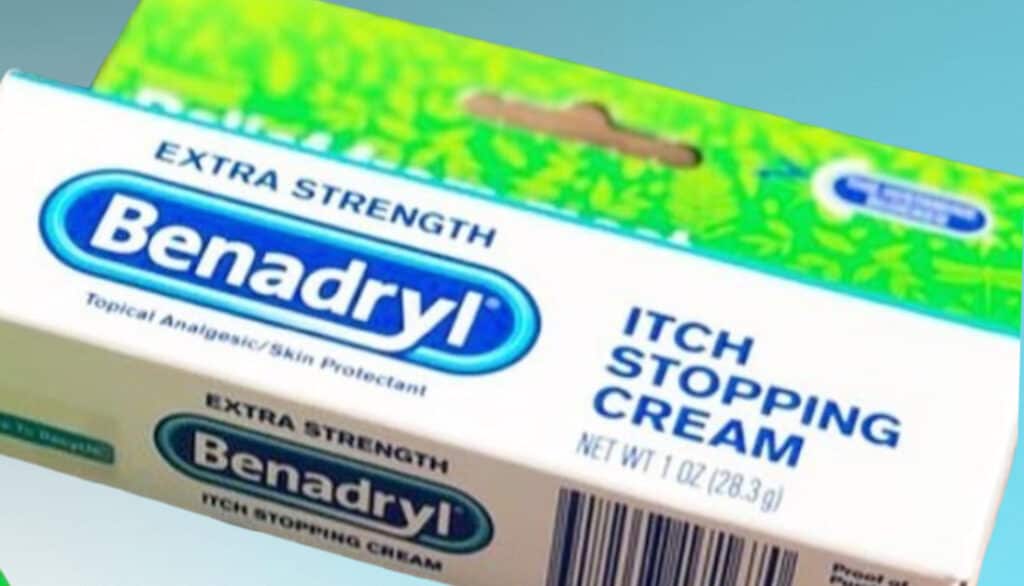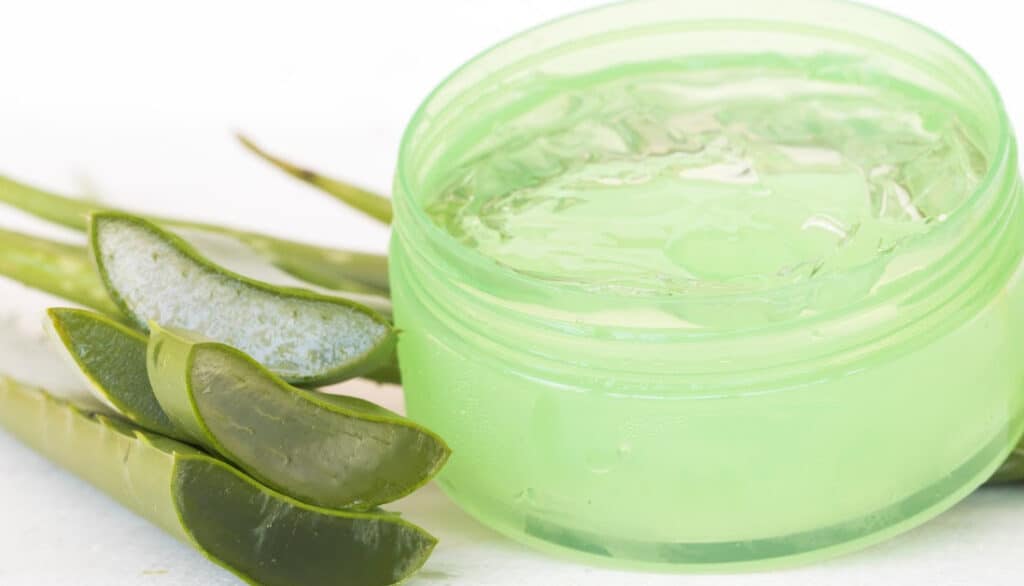Introduction
If you’re a dog owner, it’s likely that at some point you’ve had to deal with skin irritations on your furry friend. Itching, rashes, and hot spots can be common problems for dogs, and it can be tempting to turn to over-the-counter remedies like Benadryl cream for quick relief. Before you reach for that tube of cream, ask yourself “Can I put Benadryl cream on my dog?”. The short answer is yes! You can use beneryl cream on your dog in certain situations.

The Importance of Understanding If Benadryl Cream Can Be Used on Dogs
Dogs are beloved members of our families, so their health and safety are paramount. The last thing any pet owner wants is to inadvertently cause harm to their furry friend by using inappropriate treatments.
Benadryl cream may seem like a harmless solution for skin irritations. The truth is that not all human medications are safe or effective for use in dogs. It’s crucial to recognize that your dog’s skin is different from yours. They have more hair follicles per square inch than humans do, which means their skin can absorb topical medications differently.
Additionally, dogs may react differently to certain ingredients found in human creams and lotions. By understanding the potential risks associated with using Benadryl cream on dogs, you can make an informed decision about what treatments are best for your pet.
While there are many topical treatments available specifically designed for dogs’ skin issues, they may not always be readily available or affordable. That’s why it can be tempting to try out a product like Benadryl cream as an alternative solution.
However well-intentioned this may be, there are still a few things you need to consider before applying any medication to your pet. Ultimately, learning whether or not Benadryl cream is safe for use on dogs is an essential part of being a responsible pet owner.
In the following sections, we’ll delve deeper into what Benadryl cream is, its active ingredients and their effects on dogs. Also, what factors to consider before using it on your furry friend. So let’s get started!

What is Benadryl Cream?
If you’ve ever suffered from allergies, you’re likely familiar with the popular antihistamine medication called Benadryl. Benadryl cream is a topical version of this medication that’s designed to provide relief for skin irritations, itchiness, and insect bites. The active ingredient in Benadryl cream is diphenhydramine, an antihistamine that works by blocking the effects of histamines in the body.
Benadryl cream can be purchased over-the-counter at most drugstores and comes in small tubes or bottles. It’s important to note that while Benadryl cream may provide temporary relief for skin irritations in humans, it’s not necessarily safe or recommended for use on dogs.
Active Ingredients and their Effects on Dogs
The active ingredient in Benadryl cream, diphenhydramine hydrochloride, can be effective at treating certain skin conditions in dogs. However, when it comes to using any type of medication on your furry friend, it’s crucial to understand the potential side effects and risks involved.
Some veterinarians might recommend using a topical antihistamine like Benadryl cream to treat mild itching or inflammation caused by insect bites or allergies. But before applying any medication to your pet’s skin, it’s important to read the label carefully and consult with your veterinarian about proper dosage guidelines.
Overall, while Benadryl cream can be effective at treating certain skin conditions in dogs, it’s important to approach any type of medication with caution.

Can I Put Benadryl Cream on My Dog?
As a dog owner, it’s natural to want to provide the best care possible for your furry friend. One question that many pet owners have is whether or not they can use Benadryl cream on their dogs.
After all, this cream is commonly used to treat itching and swelling in humans, so why not use it on dogs as well? The short answer is yes, you can use Benadryl cream on your dog. There are some important factors to consider before doing so.
Factors to Consider Before Using Benadryl Cream on Dogs
Before using any medication or treatment on your dog, it’s important to consider a few key factors. First and foremost, you should always consult with your veterinarian before using any new product on your pet. Your vet will be able to advise you about the safety of using Benadryl cream specifically for your dog’s needs.
Additionally, you should carefully read the label instructions for the product and make sure that you understand how much cream to apply and how often. You should also pay attention to any warnings or precautions listed on the label, such as whether or not the product is safe for use around the eyes or mouth.
Dosage Guidelines for Dogs
When it comes to using Benadryl cream on dogs, dosage guidelines are very important. This will depend largely on the size of your dog and their specific condition. As a general rule of thumb, most veterinarians recommend starting with a small amount of cream applied directly to the affected area.
If there is no improvement after 24 hours of this first application, you may need to increase the dosage gradually over time until relief is achieved. It’s important not to exceed the recommended dose specified by either your vet or by label instructions.

Risks and Potential Side Effects
While Benadryl cream can be effective at treating itching and swelling in dogs, there are also some potential risks and side effects to be aware of. For example, some dogs may be allergic to the active ingredients in the cream, which could lead to an adverse reaction.
Additionally, using too much of the product or applying it too frequently can cause skin irritation or other issues. In rare cases, Benadryl cream can also cause more serious side effects such as seizures or difficulty breathing.
If you notice any signs of an adverse reaction in your dog after using Benadryl cream – such as increased itching or swelling. You should stop use immediately and consult with your veterinarian.
There are certain situations where this product can be helpful for treating skin irritations in dogs. By considering factors like dosage guidelines and potential risks before using Benadryl cream on your furry friend, you can help ensure that they receive safe and effective relief from their symptoms.

When should I use Benadryl cream on my dog?
As a dog owner, it’s important to know when to use Benadryl cream on your furry friend. It can be used for various skin conditions such as itching, rashes, and insect bites. However, it’s crucial to know the right time to apply it.
Foremost, if your dog is experiencing mild symptoms, you can apply Benadryl cream on the affected area. However, if the symptoms persist or worsen over time, it’s best to consult with a veterinarian.
Common skin conditions in dogs that can be treated with Benadryl cream
Benadryl cream can help treat several minor skin conditions in dogs. One common condition is hot spots which are areas of inflamed skin caused by excessive scratching or licking. Itching due to fleas or allergies is another common condition that can be treated with Benadryl cream.
Other conditions include contact dermatitis caused by irritants like poison ivy and other plants. Additionally, Benadryl cream may be used for insect bites and stings that cause itching and swelling.
How to identify if your dog needs treatment with Benadryl Cream
It’s essential to understand when your dog requires treatment with Benadryl cream. Excessive scratching or licking, redness and swelling around an area on their body, could indicate an allergy or hot spot. Another sign might be that they have developed bumps or rashes along their backside near their tail region where fleas tend to congregate most often.
If you observe any of these signs in your pet – you should consult a vet first before applying any medication. It’s also important to note that Benadryl cream should never be used on open wounds or sores, as it can cause further irritation and slow down the healing process.

Alternatives to Using Benadryl Cream on Dogs
Other Topical Treatments for Skin Conditions in Dogs
While Benadryl cream can be effective, there are other topical treatments that pet owners can consider. One option is hydrocortisone cream, which contains a steroid hormone that reduces inflammation and relieves itching. This cream can be applied to the affected area up to three times a day. It should not be used for more than seven consecutive days.
Another option is calamine lotion, which contains zinc oxide and reduces itching and irritation. This lotion can be applied directly to the affected area up to four times a day.
It’s important to note that calamine lotion should not be used on open wounds or areas where the skin is broken. Aloe vera gel is another topical treatment that pet owners may consider for their dog’s irritated skin.
This natural remedy has anti-inflammatory properties and can help soothe and heal the skin. It’s important to use pure aloe vera gel with no added chemicals or preservatives. These could further irritate your dog’s skin.
Natural Remedies for Skin Irritations in Dogs
In addition to topical treatments, there are also many natural remedies that pet owners may consider for their dog’s irritated skin. One of the most common natural remedies is oatmeal baths.
Oatmeal has anti-inflammatory properties and helps soothe dry, itchy skin. To give your dog an oatmeal bath:
- Grind up plain oatmeal into a fine powder
- Mix it with warm water until it forms a paste-like consistency
- Apply the paste to your dog’s skin and let it sit for 10-15 minutes before rinsing off with warm water.
Coconut oil is another natural remedy that can be effective in treating certain skin conditions in dogs. This oil has anti-inflammatory and antibacterial properties and can help soothe and heal irritated skin. Simply apply a small amount of coconut oil to the affected area.
Apple cider vinegar is another natural remedy that can be used to treat certain dog skin conditions. This vinegar has antibacterial properties and helps balance the pH level of the skin. To use apple cider vinegar on your dog’s skin:
- Mix equal parts vinegar and water
- Apply it directly to the affected area with a cotton ball or spray bottle
Chamomile tea can also be used as a natural remedy for irritated dog skin. Chamomile has anti-inflammatory properties and can help relieve itching and irritation.
- Steep chamomile tea bags in hot water for 5-10 minutes,
- Let them cool
- Apply them directly to your dog’s irritated skin.
Overall, there are many alternatives to using Benadryl cream on dogs for treating certain skin conditions. It’s important to consult with your veterinarian before trying any new treatment option for your pet’s health and safety.

Final Thoughts and Recommendations
When it comes to treating skin irritations in dogs with Benadryl cream or any other medication, it is important to prioritize your pet’s safety and well-being above all else. Always consult with your veterinarian before administering any medication or treatment to your dog.
If you do decide to use Benadryl cream on your dog, be sure to follow dosage guidelines carefully and monitor for any adverse reactions such as excessive drowsiness or difficulty breathing. If you notice any concerning symptoms after administering Benadryl cream to your pet, contact your veterinarian immediately.
In addition to medication-based treatments like Benadryl cream, there are many natural remedies that can be effective in treating skin irritations in dogs. For example, oatmeal baths can soothe itching and inflammation caused by allergies or insect bites.
Apple cider vinegar can also be used as a natural antiseptic for minor wounds or hot spots. Remember, every dog is unique and may require different treatments for skin irritations.
If you are unsure of the best course of action for your pet, consult with your veterinarian who can provide individualized recommendations based on your dog’s specific needs and medical history. By following these guidelines and prioritizing your pet’s well-being, you can effectively manage and treat skin irritations in dogs and ensure that your furry friend remains happy and healthy.
~ Dr. Candy
